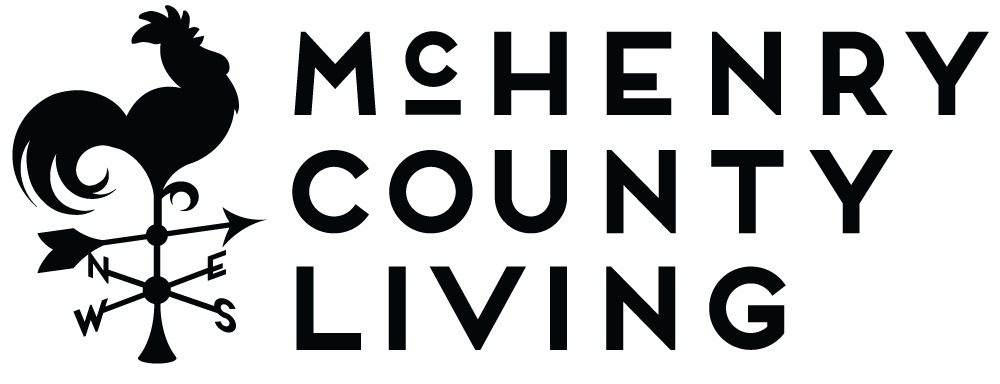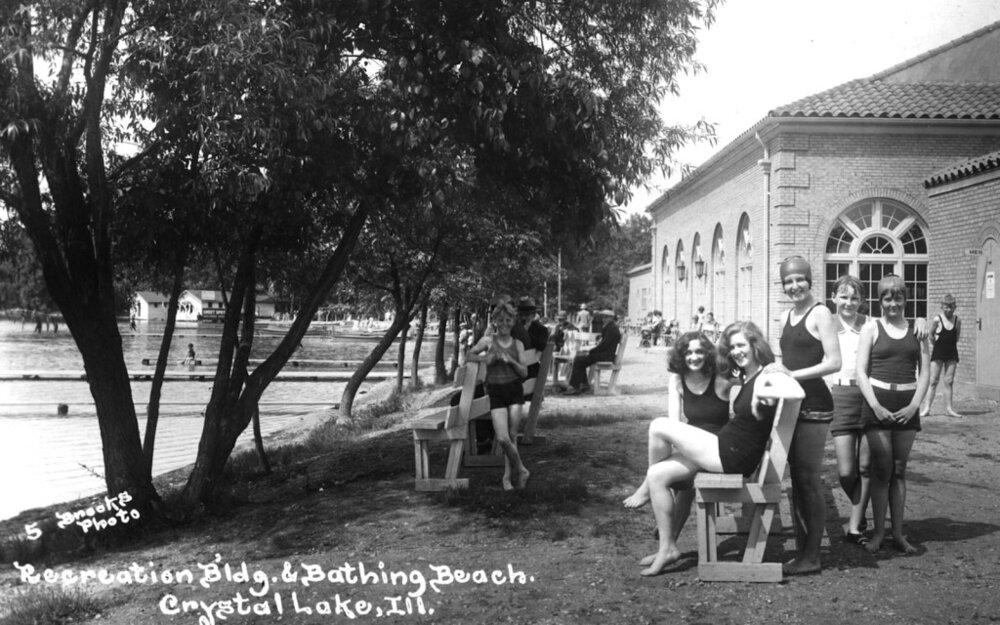A Day at the Beach in Crystal Lake
The making of Crystal Lake’s public Main Beach as we know it was anything but smooth sailing.
By Jeff Ruetsche
The creation of Crystal Lake’s Main Beach was a riot — literally. In 1921, hundreds of angry residents massed along the south shore to protest the strong-arm tactics of Consumers Ice Co. in denying public access to the lakefront, according to the Crystal Lake Herald. Tempers flared and a fence erected by Consumers to block the old frontage road was ripped down.
Thanks to a prevalence of cooler heads, however, an outright brawl between local men and Chicago “sluggers” employed as muscle by Consumers was narrowly avoided.
It is a peculiar scene to envision taking place at what is today such a peaceful setting. Yet this singular event set in motion two distinct and complementary movements: creation of the Crystal Lake Park District with its Main Beach and the establishment of a private residential area we now call “The Gates.”
Main Beach
By the Roaring Twenties, locals and visitors alike had long enjoyed “bathing” privileges at Crystal Lake. For decades, following the example first set by Charles S. Dole in the 1850s, a succession of ice companies owning the property had allowed recreational lakefront use to the public. But with the end of the ice industry, residents feared that Consumers would vacate the old Dole estate and see it converted to private property, including the lakefront, thereby denying them access to the picnicking, fishing and swimming rights so long taken for granted. The riot set such fears into overdrive.
The solution? Establish a park district, buy up the property from Consumers, and build a public beach and lakeside park to be used in perpetuity by the people of Crystal Lake. That idea met with resounding approval at a public meeting in September 1921.
Meanwhile, the city of Crystal Lake wasted no time in rejecting an offer made by Consumers — “a great and soulless corporation” according to one Herald editorial — to sell it a stretch of “swamp land,” including a mere 600 feet of beachfront. The city argued that in 1878, Mr. Dole had dedicated to the village of Crystal Lake the full park property and that “the general public has used it ever since.”
“We are having many requests from private parties to purchase the same premises,” Consumers responded forcefully in a letter addressed to the Crystal Lake Park Committee. “And we must ask that you either accept the proposition … or we shall consider that you are not interested … and you can consider the proposition withdrawn.”
The issue of forming a park district went to public vote on November 23, 1921, with 1,068 votes for, opposed to only 92 against. “A vote against the park district is a vote to close the lakefront forever,” had warned the Crystal Lake Herald, and evidently Crystal Lake residents heartily agreed.
The first action of the newly elected Board of the Crystal Lake Park District was to take legal action against Consumers.
Consumers was found at fault, the property condemned, and by virtue of court order, 1,500 feet of beach and 22 acres of surrounding park awarded to the Crystal Lake Park District for the price of $19,250. The people of Crystal Lake had secured their lake and beach rights, and they enjoy them still generations later.
The Gates
Meanwhile, a movement toward a more exclusive area of private homes was underway on the southwestern shore of Crystal Lake. A group of investors led by the widow Mrs. “Lou” Ringling, heiress to a circus fortune, bought the remaining old Dole estate from Consumers and transformed it into the Crystal Lake Country Club. The club then platted an upscale private housing development, Country Club Additions. Plots were set aside for small private parks and beaches, as an ad for Country Club Additions touted its “aim to build up an exclusive colony of congenial people, and attractive homes.”
The Additions experienced a building boom in the 1920s. By 1926 — the same year the Recreation Building opened to the public at CLPD Main Beach — 36 new private homes had gone up. Around 1929, chains were put up across side streets — these chains serving as gates — in an “attempt to keep the community private.” Signs across Country Club Additions declared the area a “restricted community,” and soon thereafter came to be called “The Gates” as the narrow roads were yet to be named.
The Gates attracted some interesting homes — and interesting characters, too, such as the Schiller House at 380 Hampshire. Frederick Schiller, an artist at Crystal Lake’s Terra Cotta Industries — whose designs were in great demand by Chicago-area theaters — built this home in the 1930s. Schiller also owned a tavern (possibly where the current General Store stands) with slot machines and resident gangsters. Ed Schiller, the couple’s son, recalled the thrill of getting a ride to school from “nice gangsters with machine guns” who lived in the neighborhood.
The Schwinn House at 930 South Shore was built by Ignaz Schwinn of the bicycle brand fame for his daughter, Lola, and her newlywed, Edwin Beauschauen. Among other eccentricities, the Schwinn house was known for having a firing range in its basement; extravagant Christmas decorations, including a pipe organ and mechanical choir; and a garden house built by later tenants to house a drunken sibling — the so called “Bar House” at 910 South Shore.
John Barrett — vice president of International Harvesters — built the Barrett House at 362 Melrose Lane between 1929 and 1931. He used employees of International Harvester as labor since they were kept on the payroll during the Depression. The Barretts used adjacent lots to raise very noisy turkeys and chickens, much to the ire of their immediate neighbors in The Gates.
The part of Country Club Additions that Mrs. Ringling lived in was annexed to Crystal Lake in 1929. The rest remained unincorporated. By 1933, however, residents in this unincorporated area realized the need for police and fire protection, especially since many lived there part time and break-ins or fires were all too common. The movement toward becoming a village took on momentum. “Lakewood” was suggested as a new village name and, on July 8, 1933, at the corner of Lake Avenue and Gate 7 (Cumberland Lane), 52 residents voted unanimously in favor of incorporation.
The Lakefront Today
Whether you drop your child off for karate lessons at the Main Beach House, cast away for bass or catfish at that favorite fishing spot, or participate in the Crystal Lake Rowing Club off West Beach, you can thank early visionaries of the Crystal Lake Park District for today’s recreational opportunities.
Likewise, the small private beaches dotting the lake’s southwest shore and the well preserved historic homes of The Gates are testament to the work of Lakewood residents and preservationists dating back decades.

